| Pages:
1
2 |
symboom
International Hazard
    
Posts: 1143
Registered: 11-11-2010
Location: Wrongplanet
Member Is Offline
Mood: Doing science while it is still legal since 2010
|
|
The neurochemicals in nature
I have been working on a project took a while in categorizing herbs in what general receptors are activated
Serotonin
Dopamine
Adrenaline
NMDA
Opioid
Histamine
Nmda antagonist
Psychotria colorata
psychotridine
hodgkinsine
Psychotria lyciiflora
hodgkinsine
quadrigemine C
isopsychotridine B
psychotridine
quadrigemine
oleoidine
caledonine
Calycodendron milnei
Hodgkinsine
Tabernaemontana divaricata
conolidine
tabernaemontanine,
coronarine,
coronaridine,
dregamine.
Acourous calamus
alpha-asarone,
beta-asarone
gamma-asarone
Hodgkinsonia frutescens
Hodgkinsine
Cats claw
Rhyncophylline
speciophylline
uncarine F
pteropodine
isopteropodine
mitraphylline
isomitraphylline
Isorhynchophylline
Sophora flavescens
Matrine
matrine oxide,
Kushenin
Sophoraflavanone
7,9,2',4'-Tetrahydroxy-8-isopentenyl-5-methoxychalcone
Sophoridine
Trifolirhizin,
8-Prenylkaempferol
Oxysophocarpine
sophocarpine
Corydalis yanhusuo
Dehydrocorybulbine
Glaucine
Glaucium flavum
Glaucine
Croton lechleri
Glaucine
Stephania rotunda
Tetrahydropalmatine
pukatea
Pukateine
Phellodendron amurense
Hodgkinsine
Galbulimima belgraveana
himbacine
Himgrina
Himgravina
Himandravina
Himbelina
Zizyphus jujuba
Sanjoinine A
Cyperus articulatus
alpha-corymbolol,
alpha-cyperone,
alpha-pinene
carophyllene oxide
corymbolone
Cyperotundone,
mustakone.
Cyperotundone
alpha-cyperone.
Articulone,
copaene,
α-corymbolol,
β-corymbolone,
mandassidione
caryophyllene oxide,
trans-pinocarveol,
myrtenal,
myrtenol,
ledol,
Cyperotundone,
alpha-cyperone
Bacopa monnieri
brahmine,
nicotine,
herpestine
D-mannitol,
apigenin,
hersaponin,
monnierasi
bacopaside I
bacoside A3
bacopaside II
bacopasaponin C
Searsia pyroides ethanol extract also depressed the NMDA stimulated increase in intracellular Ca.
Dangers
K hole
NMDA agonist
Dangers
Glutamate toxity
Alanine
Aspartic acid
Glutamic acid
Glycine
Serine
Seritonin agonist
Antidepression
The tryptamine psychedelics, such as DMT and psilocybin, structurally resemble serotonin itself. The phenethylamine psychedelics on the other hand,
such as mescaline, and compounds of the 2C family, more closely resemble the neurotransmitter dopamine.
Sceletium tortuosum
mesembrine,
mesembrenone
mesembrenol
Tortuosamine.
Lespedeza bicolor
Yopo
2,9-dimethyltryptoline
2-methyltryptoline
5-MeO-DMT
5-Methoxy-N-methyltryptamine
Bufotenin
Bufotenin-oxide
Catechol
Leucoanthocyanin
Leucopelargonidol
DMT
DMT-oxide
Methyltryptamine
Orientin
Saponarentin
Viterine
Fittonia albivenis
Justicia pectoralis
Prestonia amazonica
Acacia acuminata
Albizia inundata
Voacanga africana
Prestonia amazonica
Delosperma cooperi
Serotonin antagonist
Reserpine Depletes serotonin stores in the brain, heart, and many other organs
Feverfew
red panax ginseng
chastetree
Dopamine agonist
antiparkinson agents are normally agonists and treat ADHD
L-phenylalanine,
L-tyrosine
l_dopa
Mucuna pruriens
L_dopa
Vicia faba
L_dopa
Ulvaria obscura
L_dopa
Chaenomeles speciosa
(Flowering Quince)
Chaenomeles sinensis
Oroxylum indicum
Oroxylin A
Scutellaria baicalensis (Skullcap)
Oroxylin
Dopamine antagonist
Antipsychotics
dopamine antagonists, and as such they have found use in treating schizophrenia, bipolar disorder, and stimulant psychosis
Gaba antagonist
thujone
Thujone
mugwort,
oregano,
common sage
Artemisia absinthium
ginkgo biloba
ginkgolic acids
adipostatin A
kudzu
puerarin
daidzein,
daidzin
genistein
mirificin
salvianolic acid
muira puama
Coumarin,
lupeol
muirapuamine.
Gaba agonist
Amanita muscaria
ibotenic acid
muscimol
Skullcap
wogonin,
wogonoside,
baicalin,
apigenin,
oroxylin A,
scutellarein,
skullcapflavone.
ashwagandha
tropine
cuscohygrine
withaferin A,
chamomile
Apigenin
Albizza juberilone
Kava
ncluding kavain,
dihydrokavain,
methysticin,
dihydromethysticin,
yangonin,
desmethoxyyangonin
flavokavain A,
flavokavain B
Flavokavain C
Adrenergic agonist
Betel nut (areca nut, paan)
Arecoline
Tobacco
Nicotine
butcher's broom
ruscogenin
neoruscogenin
bitter oranage
N-methyltyramine,
octopamine
synephrine
bitter yam
coca (cocaine)
Benzoylecgonine
Cocaine
Ecgonidine
Ecgonine
Hydroxytropacocaine
Methylecgonine cinnamate
Tropacocaine
Truxilline
Cuscohygrine
Dihydrocuscohygrine
Hygrine
Nicotine
ephedra.
ephedrine
pseudoephedrine
norephedrine,
Norpseudoephedrine
Acorus calamus
alpha-asarone
Beta-asarone
gamma-asarone
eugenol
Anamirta cocculus
berberine,
palmatine,
magnoflorine
columbamine
Areca catechu
arecaidine
arecoline,
................
Catuaba
What gives strength to the indian
Trichilia catigua
Cinchonain-Ib
Erythroxylum vaccinifolium.
catuabines.
Other catuaba preparations use the bark of trees from the following genera or families: Anemopaegma, Ilex, Micropholis, Phyllanthus, Secondatia,
Tetragastris and species from the Myrtaceae
Holly
caffeic acid,
caffeoyl derivatives,
caffeoylshikimic acid,
Chlorogenic acid,
Feruloylquinic acid,
quercetin,
quinic acid,
kaempferol,
tannins
, rutin,
caffeine
theobromine
...........
chocolate
Theobromide
Contrayerva
contrajervin
cajapine,
dorsjervin A,
dorsjervin B,
psoralen,
dorstenin,
squalene,
γ-sitosterol,
cycloartocarpesin,
1-O-linolenoyl-2-O-stearoyl-3-O-ß-D-galactopyranosyl glycerol,
bergapten,
dorsteniol,
xanthoarnol
Guarana
caffeine
theophylline
Theobromine
Khat
cathinone
cathine
Nicotiana rustica
nicotine nine times more than common tobacco
Harman
norharman
Sida cordifolia
ilima flannel weed, bala, country mallow or heart-leaf sida mallow family
β-phenethylamine
Ephedrine,
pseudo-ephedrine
hypaphorine,
vasicinone,
vasicinol,
choline
betaine.
Tea
4% caffeine
theobromine.
Tobacco
Nicotine
rutin
chlorogenic acid
glutamic acids,
asparagine
, glutamine
γ-Aminobutyric acid
Nornicotine
anatabine
anabasine,
myosmine
cotinine
Yerba mate
Caffeine,
theobromine
theophylline
Yohimbe
yohimbine.
corynanthine
Indian snake root
Rauvolfia serpentina
ajmaline
, ajmalicine,.
ajmalimine,
deserpidine,
indobine,
indobinine,
reserpine,
reserpiline,
rescinnamine,
rescinnamidine,
serpentine,
serpentinine
yohimbine.
Adrenergic antagonist
???
Anticholinergic
spasmolytic, anti-asthmatic, anticholinergic, narcotic and anesthetic
Hyoscyamus niger,
Atropa belladonna,
Mandragora officinarum
hyoscyamine
, hyoscine,
cuscohygrine,
apoatropine,
3-alpha-tigloyloxytropane
, 3-alpha,6-beta-ditigloyloxytropane
belladonnine
Datura
Tassel bush
Nutmeg
Canarium luzonicum
Amanita muscaria
Cholinergic
lemon balm,
sage,
rosemary,
ginkgo,
gotu kola
Chinese club moss
Vinca minor
Vincaminol
vincamine.
reserpine
, reserpinine
, akuammicine
, majdine,
vinerine,
ervine,
vineridine,
tombozine,
vincamajine,
vincanine,
vincanidine,
vincamone,
apovincamine,
vincaminol,
desoxyvincaminol,
vincorine
perivincine.
Nootropics
Alpha-GPC (
Citicoline
Galanthus caucasicus
Tyrosine
Creatine
Histamine agonist?
???
Histamine antagonist
Stinging Nettle
Quercetin.
Bromelain.
Vitamin C.
Opiate agonist
Opium poppy
Kratom
Akuamma
akuammidine,
akuammine,
akuammicine,
akuammigine
pseudoakuammigine.
Periwinkle
Nauclea latifolia
Tramadol
Dalea purpurea
pawhuskin A,
pawhuskin B,
pawhuskin C,
Petalostemumol
Salvia divitorium
Commiphora Myrrh
furanoeudesma-1,3-diene
Peripentadenia Mearsii
- peripentonine A, B, and C,
peripentadenine
mearsamine
Peripentadenine,
Psychotria Colorata
Psychotridine
Hodgkinsine
Nigella Sativa
thymoquinone
Stephania japonica
-8 Hasubanan alkaloids and 1 morphinane alkaloid have been isolated from this vine.
Actaea racemosa-Contains a partial mu-opioid agonist.
Elaeocarpus grandis
grandisine A, B, C, D, E, F, G
isoelaeocarpiline.
Elaeocarpus fuscoides-
elaeocarpenine,
isoelaeocarpicine
, isoelaeocarpine
elaeocarpine .
Opiate antagonist?
???
Cannabinoid agonist
Liverwort
Perrottetinene
Perrottetinic acid
Coneflower – Echinacea
cannabimimetic
N-alkyl amides
Oxeye - Heliopsis helianthoides
cannabimimetic
N-alkyl amides
Electric daisy - Acmella oleracea
N-Isobutylamides
Helichrysum umbraculigerum
cannabigerol
Liverwort – Radula marginata
perrottetinenic acid is remarkably similar to THC.
Chocolate
FAAH is responsible for the breakdown of an endocannabinoid known as anandamide in our bodies. Anandamide is our natural version of THC
Black pepper- Piper nigrum
Beta-caryophyllene (BCP)
Herbs found to engage with the endocannabinoid system. A couple others include Peruvian maca and Chinese rhododendron.
Refrences
https://herb.co/marijuana/news/non-marijuana-plants-contain-...
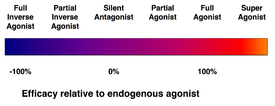
[
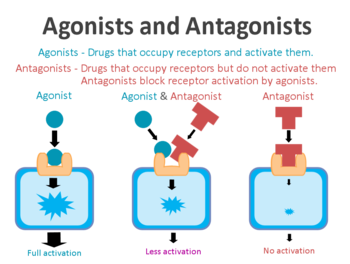
[Edited on 5-4-2018 by symboom]
[Edited on 5-4-2018 by symboom]
|
|
|
rase
Harmless

Posts: 5
Registered: 25-3-2019
Member Is Offline
|
|
nice list
Hello,
nice list you have there...
can you tell whats the best sources for that herbs?
Thanks
|
|
|
j_sum1
Administrator
       
Posts: 6371
Registered: 4-10-2014
Location: At home
Member Is Offline
Mood: Most of the ducks are in a row
|
|
rase
Your various posts are spamming. I have deleted the worst and sent one thread to detritus.
If you want to contribute or participate then fine.
If you want to add meaningless comments to old threads or ask how to use a tea bag then go somewhere else.
[/modding]
|
|
|
MineMan
International Hazard
    
Posts: 1030
Registered: 29-3-2015
Member Is Offline
Mood: No Mood
|
|
Symboom. You have k-hole listed under NMDA... is this from herbs? I always thought the k-hole was just from ketamine. If so. These herbs could be
potent antidepressants.
|
|
|
karlos³
International Hazard
    
Posts: 1520
Registered: 10-1-2011
Location: yes!
Member Is Offline
Mood: oxazolidinic 8)
|
|
You have listed Nauclea latifolia as a natural source of tramadol.
That is wrong.
This plant does not biosynthesise that itself, actually the cattle herders feed the cattle massive amounts of tramadol, and when they excrete it and
its metabolites out in their urine, it gets absorbed from the plant, that is where it comes from.
|
|
|
SWIM
National Hazard
   
Posts: 970
Registered: 3-9-2017
Member Is Offline
|
|
These long lists would be a lot more useful if you included some references and explanatory comments.
You're obviously putting a lot of work into these, but a little more explanation and some citations for each separate material could make them REALLY
useful to people who lack your considerable knowledge.
|
|
|
MineMan
International Hazard
    
Posts: 1030
Registered: 29-3-2015
Member Is Offline
Mood: No Mood
|
|
Agreed. If this list was better organized with explanations it could really help people whom doctors have failed or who want to go the natural path.
|
|
|
symboom
International Hazard
    
Posts: 1143
Registered: 11-11-2010
Location: Wrongplanet
Member Is Offline
Mood: Doing science while it is still legal since 2010
|
|
Here is what I have been working on it has been hard to find information on what a lot of plants affect in the body. Sometimes the only information I
can find is it's a stimulant sedative or for pain relief.
Like categorizing herbs based on what thransmitter they effect serotonin, acetylcholine, gaba, etc...
Next I'll probably compare herbs and their affect on enzyme activation or deactivation.
I'm working on better organizing the information
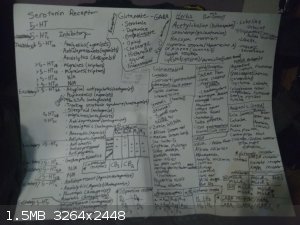 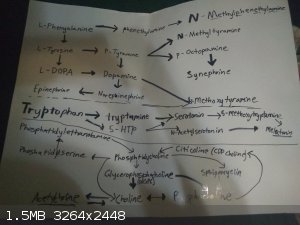
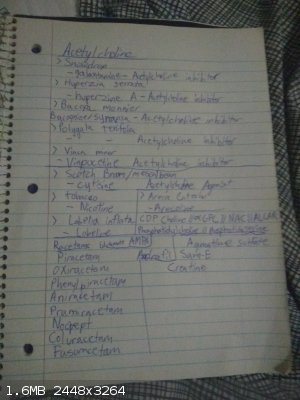
[Edited on 14-7-2020 by symboom]
[Edited on 14-7-2020 by symboom]
|
|
|
mackolol
Hazard to Others
  
Posts: 459
Registered: 26-10-2017
Member Is Offline
Mood: Funky
|
|
You can add magnolol and honokiol to your list, which are GABA A agonists naturally occurring in magnolia bark. They are said to work pretty well and
even to help in benzodiazepines withdrawal.
|
|
|
BrainAmoeba
Harmless

Posts: 15
Registered: 12-7-2020
Location: It depends...
Member Is Offline
Mood: Poisoned
|
|
Nice list. I hope that it will be even more informative after some modifications.
|
|
|
symboom
International Hazard
    
Posts: 1143
Registered: 11-11-2010
Location: Wrongplanet
Member Is Offline
Mood: Doing science while it is still legal since 2010
|
|
Can't edit it but here is a big list of notropics that don't just increase acetylcholine
https://nootropicsexpert.com/nootropics-list/#rhodiola-rosea
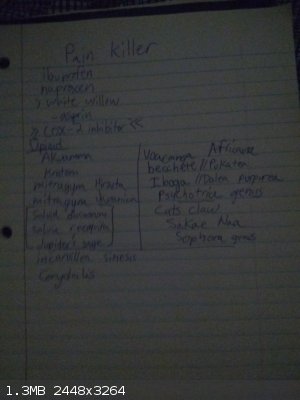
[Edited on 16-7-2020 by symboom]
|
|
|
symboom
International Hazard
    
Posts: 1143
Registered: 11-11-2010
Location: Wrongplanet
Member Is Offline
Mood: Doing science while it is still legal since 2010
|
|
#DOPAMINERGIC#
Sacred lotus/ Nuciferine - can potentiate morphine analgesia.
Blue lotus/Apomorphine - agonist
Mucuna Pruriens / L-Dopa
Flowering quence - Dopamine reuptake inhibitor
Blue trumpet vine
P corylifolia
Oroxylum indicum/ Oroxylin A - Dopamine reuptake inhibitor
Skullcap/ Oroxylin A - - Dopamine reuptake inhibitor
___________________
# SEROTONERIC#
Kanna / mesembrine, mesembrenone - SSRI
St. John's wort - monoamine reuptake inhibitor (MRI),
Argyreia Nervosa / Ergine(LSA)
Morning glories / Ergine(LSA)
San Pedro / Mescaline
Peyote / Mescaline
Vilca / Bufotenin
Virola Elongata / DMT, 5-MeO-DMT
Red Ucuuba / DMT, 5-MeO-DMT
Jurema / DMT
Acacia species / DMT
Psychtria Viridis / DMT
Psilocybin mushroom / Psilocybin
Dictyonema huaorani / 5-MeO-DMT, DMT, Psilocybin
___________________
#OPIOIDERGIC#
Becche
iboga
Voacanga Africans
Phychotria Colorata
Salvia divatorum
Jupiter sage
Salvia recognia
Opium poppy
Akuamma
Kratom
Mitragyna hirsuta
Mitragyna javanica
_______________________
#ADRENERGIC#
Yerba mate /caffeine, theobromine, and theophylline
Yohimbe / Yohimbine
Coffee / Caffine
Khat - cathinone - SNRI
Tea / Caffine
Sida Cordifolia / ephedrine, pseudoephedrine
Catuba / catuabine A, B, C
Coca / cocaine
Ephedra sinica / ephedrine, pseudoephedrine
Eria Jarensis / N,N-DMPEA
_________________
#CHOLINERGIC#
Snowdrop /Galantamine - acetylcholinesterase inhibitor
Huperzia serrata / Huperzine A - acetylcholinesterase inhibitor
Bacopa Monnier / bacopasides I–XII, brahmine, and herpestine
Polygala Tenifolia
Vinca Minor / vincamine
Intellect Tree
Scotch Broom / Cytisine
Tobacco / Nicotine
Mescalbean /Cytisine
Lobelia Inflata / Lobeline
Areca Catechu / Arecoline
_________________
#CANNABINERGIC
Cannabis
Liverwort
Coneflower – Echinacea
Oxeye - Heliopsis helianthoides
Electric daisy
Helichrysum umbraculigerum
_________________
#GABAergic#
Kava
Valarian root
Magnolia
__________________
#MAOI#
Nutmeg
Ayahuasca vine
Passion flower
Syrian Rue
Grape fruit
Licorice
Black pepper
Tumeric
____________________
#Other Analgesic#
Rhodiola rosea -Endorphin releasing agent and MAOI
Sakae Naa
Incarvillea sinesis
Snapdragon root
Sophora genus
Corydalis
Scullcap
Pukatea
Chuchuhuasi
Lettuce opium
Devil's backbone
White Willow
Cats Claw
yellow horned poppy
_________________
#Other Sedative
Indian snakeroot - antiphycotic
Albiza
Indian warrior
common devil pepper
Silene capensis
_________________
#Other Stimulant
Contrayerba
Goldenseal
Bitter orange
_________________
#Unknown
Rhodiola Crenulata
Wild dagga
Coleus
Galangal
Horse Chestnut
Zornia latifolia
Calamus
Mulungu
Sun Opener
Calea Dream Herb
African dream root
African dream herb
Sugandi dream root
Edit still in progress
May have a short discription. Figured out the best layout for the post to be easier to read.
Intellect tree
celastrine, celapanine, celapanigine, celapagin, malkangunin and paniculatine.
[Edited on 22-7-2020 by symboom]
|
|
|
symboom
International Hazard
    
Posts: 1143
Registered: 11-11-2010
Location: Wrongplanet
Member Is Offline
Mood: Doing science while it is still legal since 2010
|
|
Neurotransmitters
Amino Acids: glutamate, aspartate, glysine, GABA.
Monoamines: dopamine, serotonin, histamine, noradrenaline.
Peptides: substance p, opioid peptides.
Others: acetylcholine, adenosine, nitric oxide.
Herbs containing an antagonist
Dopamine antagonist
Indian snakeroot
Bacopa
Noni
Magnolia
Licorice
Serotonin antagonist
Rauvolfia serpentina/ Reserpine
Feverfew
Chastetree (vitex Dopamine agonist)
Opioid antagonist
N/A
Norepinephrine antagonist
N/A
Cannabidiol antagonist
N/A
Acetylcholine antagonist
Latua
Mandragora
Hyoscyamus
Duboisia (corkwood tree)
Datura
Brugmansia
Atropa belladonna (Nightshade)
Myristica fragrans (Nutmeg)
GABA antagonist
mugwort,
oregano,
common sage
Artemisia absinthium
Ginkgo biloba
Kudzu
Muira puama
++++++++++++++++++++++++
Dopamine agonists
Used in Parkinson’s disease and, to a lesser extent, to treat depression, hyperprolactinemia and restless legs syndrome.
Parkinson's disease dopaminergic neurons that produce the neurotransmitter dopamine in the brain slowly break down and can eventually die. With
decreasing levels of dopamine the brain can't function properly and causes abnormal brain activity, which ultimately leads to the symptoms of
Parkinson's disease.
Hyperprolactinemia
Dopamine is a prolactin-inhibiting factor (PIFs) since it lowers the prolactin-releasing factors synthesis and secretion through DD2-like receptors.
Restless leg syndrome is identified by the strong urge to move and is a dopamine-dependent disorder
Dopamine reuptake inhibitors
used in the treatment of attention-deficit hyperactivity disorder (ADHD) and narcolepsy for their psychostimulant effects, and in the treatment of
obesity and binge eating disorder for their appetite suppressant effects.
Dopamine releasing agent
These drugs are frequently used for recreational purposes and encountered as drugs of abuse
Dopamine antagonist
treating schizophrenia, bipolar disorder, and stimulant psychosis. Antiemetics used in the treatment of nausea and vomiting.
++++++++++++++++++++++++
Serotonin agonists
They are used variously as antidepressants, anxiolytics, antiobsessionals, appetite suppressants, and entactogens
migraine and cluster headache attacks. The antimigraine effect caused by vasoconstriction of blood vessels in the brain. The same is true for
ergotamine. Female sexual dysfunction. Medication for controlling anger (antiaggression effect) Many atypical antipsychotics to effects on negative
symptoms in schizophrenia. treating certain disorders of gastrointestinal motility. Other 5-HT4 receptor agonists have shown potential to be nootropic
and antidepressant drugs
Valerenic acid, a constituent of valerian root, has been found to act as a 5-HT5A receptor agonist, and this action could be involved in the
sleep-promoting effects of valerian
Serotonin reuptake Inhibitor
Antidepressants treatment of anxiety disorders and eating disorders. Less often, SRIs are also used to treat a variety of other medical conditions
including neuropathic pain and fibromyalgia
Serotonin releasing agent
appetite suppressants, antidepressants and anxiolytics with the potential for a faster onset of action and superior efficacy relative to the selective
serotonin reuptake inhibitors
Serotonin antagonist
Used as atypical antipsychotics, Antihypertensive, treating chemotherapy-induced emesis and postoperative nausea and vomiting, and treatment of
irritable bowel syndrome
++++++++++++++++++++++++
Opioid/Opioid peptide
Opioid peptides retain some of the features of opioids, but have distinct clinical characteristics that differentiate them from traditional opioids.
Thus they defy simple classification as opioids.
Opioid peptides bind to opioid receptors in the brain; opiates and opioids mimic the effect of these peptides. The effects of these peptides
vary, but they all resemble those of opiates. opioid peptides are known to play an important role in motivation, emotion, attachment behaviour, the
response to stress and pain, and the control of food intake.
Opioid peptides
endorphin, enkephalins, and dynorphins, and 3 families of receptors, μ (MOR), δ (λ, DOR), and κ (KOR).
https://www.amboss.com/us/knowledge/Opioids
-----------------
Opioid (peptides) releasing agent
Rhodiola rosea
-----------------
Opioid(peptide) reuptake inhibitor
Enkephalinase inhibitors
D-phenylalanine inhibits enkephalinase
effects are Analgesic, antidepressant, anxiolytic, and
antidiarrheal
Endorphinase inhibitors
N/A
Dynorphinase inhibitors
N/A
-----------------
Opioid agonist
Pain relief and antidiarrheal
---------------
Opioid antagonist
These drugs are used mainly in the treatment of opioid-induced constipation. Treatment in opioid dependence to keep away withdrawn symptoms. antidote
drug for treating opioid overdose.
++++++++++++++++++++++++
Norepinephrine
Norepinephrine agonist
Norepinephrine increases alertness and arousal, speeds reaction time and ability to concentrate. Norepinephrine used as a stimulant, an antidepressant
and for treatment of ADHD
A2 norephedrine Agonist induces sedation, anesthesia, muscle relaxation, and analgesia
Norepinephrine reuptake inhibitor
NRIs are commonly used in the treatment of conditions like ADHD and narcolepsy due to their psychostimulant effects and in obesity due to their
appetite suppressant effects. They are also frequently used as antidepressants for the treatment of major depressive disorder, anxiety and panic
disorder. Add
Norepinephrine releasing agent
For the treatment of attention deficit hyperactivity disorder (ADHD). As an appitite suppressant in the treatment of obesity. As wakefulness-promoting
agents in the treatment of narcolepsy and as nasal decongestants
Norepinephrine antagonist
Used for vasodilation of blood vessels, lowering blood pressure and relieving hypertension. It's used to relieve the pain caused by myocardial
infarction, and also the infarction size, which correlates with heart rate. Also used for treatment of ureteric stones, pain and panic disorders,
withdrawal, and anesthesia
++++++++++++++++++++++++
Acetylcholine
Acetylcholine releasing agent
Treatment of Eaton-Lambert syndrome occurs when the immune system attacks nerve cells causing muscle weakness
Acetylcholine agonist
as Alzheimer's disease, schizophrenia, attention-deficit hyperactivity disorder (ADHD) Glacoma and nicotine addiction and muscle relaxant
Acetylcholine reuptake inhibitor
Used to treat myasthenia gravis as it increases neuromuscular transmission. To treat glaucoma, To treat postural tachycardia syndrome, As an antidote
to anticholinergic poisoning, To reverse the effect of non-depolarising muscle relaxants
To treat neuropsychiatric symptoms of diseases such as Alzheimer's disease, particularly apathy
To increase chances of lucid dreaming (by prolonging REM sleep)
To treat Alzheimer's disease, the Lewy body dementias and Parkinson's disease to treat the cognitive (memory and learning deficits mostly) symptoms of
dementia. To attenuate psychotic symptoms (especially visual hallucinations) in Parkinson's disease. To treat cognitive impairments in patients with
schizophrenia in treating positive, negative and affective symptoms. As a treatment for autism to increase Rapid eye movement sleep in autistic
children, in line with the mechanism by which they encourage lucid dreaming.
Acetylcholine antagonist
muscarinic acetylcholine antagonist, a type of anticholinergic, which works by causing smooth muscles to relax used in the eye for dilating the pupil
for an eye examination
Nicotinic acetylcholine antagonist
prevent motion sickness and used in the treatment of COPD by relaxing the smooth muscles
++++++++++++++++++++++++
Cannabidiol agonist
For treating vomiting and for enhancement of appetite, mainly in people with AIDS as well as for refractory nausea and vomiting in people undergoing
chemotherapy. To alleviate neuropathic pain, spasticity, overactive bladder.
(Cannabidiol)anandamide reuptake inhibitor: black pepper
suppression of pain perception (analgesia), increased appetite, mood elevation and inhibition of short-term memory.
(Cannabidiol) anandamide releasing agent
Chocolate (theobromine, phenethylamine)
elevated anandamide levels causes an immunity to anxiety, unable to experience fear and insensitive to pain. healing quicker than average.
Cannabidiol antagonist
to treat obesity and as a smoking cessation agent
++++++++++++++++++++++++
GABA
Gaba agonist
A anxiolytic, anticonvulsant, and muscle relaxant.
GABA reuptake inhibitor
A anxiolytic, anticonvulsant, and muscle relaxant.
Gaba releasing agent
N/A
GABA antagonist
produces stimulant effects, and are mainly used for counteracting overdoses of sedative drugs. And as reversing sedation.
++++++++++++++++++++++++
## Glutamate agonist ##
The AMPA receptor
mimics the effects of the neurotransmitter glutamate
Uses as a neutropic: effects are. Acuity enhancement, Colour enhancement, Auditory enhancement, Mindfulness, Tactile enhancement, Wakefulness, Anxiety
suppression ,Thought connectivity, Focus enhancement, Immersion enhancement
Motivation enhancement, Memory enhancement, and Dream potentiation
The NMDA receptor
hypofunction of NMDA receptors (due to glutathione deficientcy are involved in impairment of synaptic plasticity
The kainate receptor (KAR)
kainate receptors in the presynaptic cell can affect the amount of neurotransmitters that are released. This effect may occur quickly and last for a
long time, and the effects of repetitive stimulation of KARs can be additive over time
Glutamate reuptake inhibitor
Theanine is an analog of this amino acid, and its primary amide, L-glutamine
Glutamate antagonist
AMPA receptor antagonists
anticonvulsants used in patients with epilepsy in the treatment of partial-onset seizures
AMPA antagonist are liable to be abused; very high doses produced euphoria responses similar to ketamine. Side effects of the AMPA antagonist are
dizziness, somnolence, vertigo, aggression, anger, loss of coordination, blurred vision, irritability, and slurred speech.
NMDA receptor antagonist
They are commonly used as anesthetics for animals and humans; the state of anesthesia they induce is referred to as dissociative anesthesia.NMDA
receptor overactivation is implicated in excitotoxicity, NMDA receptor antagonists have held much promise for the treatment of conditions that involve
excitotoxicity, including benzodiazepine withdrawal, traumatic brain injury, stroke, and neurodegenerative diseases such as Alzheimer's, Parkinson's,
and Huntington's
How glutamate antagonists work. Low doses of glutamate antagonists have been shown to slow down the rate of nerve cell loss in the brain, thereby
slowing down the progression of Parkinson's. Glutamate antagonists work by inhibiting the activity of glutamate receptors in the brain.
MAOI
Uses
MAOIs have been found to be effective in the treatment of panic disorder with agoraphobia, social phobia, atypical depression or mixed anxiety
disorder and depression, bulimia, and post-traumatic stress disorder,as well as borderline personality disorder and Obsessive Compulsive Disorder
(OCD). Bipolar depression , dysmorphophobia, and avoidant personality disorder, Parkinson's disease by targeting MAO-B in particular. MAOI is used to
treat migraine prophylaxis dysthymia and hysteroid dysphoria
+++++++++++++++++++++++++++++++++
Adenosine
adenosine agonists suppress seizures and raise seizure thresholds, induces sleep.
Adenosine reuptake inhibitor
used for the treatment of acute lymphoblastic leukemia and may have applications in treating other disorders such as diabetes. stimulates glucose
uptake, suppressing (cell death) apoptosis by reducing production of reactive oxygen compounds inside the cell.
Interesting study on adenosine
improved performance in endurance-type exercise, by converting fast-twitch muscle fibers to the more energy-efficient, fat-burning, slow-twitch type.
Given to mice that did not exercise, this combination activated 40% of the genes that were turned on when mice were given GW1516 and made to exercise.
This result drew attention to the compound as a possible athletic endurance aid.
adenosine antagonist .Examples include caffeine, theophylline, and theobromine. Stimulant and Inflammation reducer
References
wikipedia.com
ScienceDirect.com
Tandfonline.com
https://www.ncbi.nlm.nih.gov/pmc/
[Edited on 23-7-2020 by symboom]
[Edited on 23-7-2020 by symboom]
|
|
|
symboom
International Hazard
    
Posts: 1143
Registered: 11-11-2010
Location: Wrongplanet
Member Is Offline
Mood: Doing science while it is still legal since 2010
|
|
Well my project has helped me greatly I'm still working on reducing the need for some of them such as the reuptake inhibitors. And leaving the
building block chemicals to stay.
Agonists could be used but it's better to work with the body
Dopamine - motivation/concentration(tyrosine/andrafil)
Acetylcholine - memory/Nitric oxide increase(a-gpc/huperzine)
Beberine - blood sugar control
Rhodiola rosea pain relief /stamina- endorphan releasing agent
Vitamin b complex
Nootropics
I've tried nooept but that is another level of focus visually and Auditory enhancing the senses and cause sensory overload
Relaxation kava or 5-htp
Wakefulness Mugwort gaba antagonist
This has helped me with having a sharper mind and then I decided I might as well exercise more too due to increased energy levels trust me it sucks
feeling tired most of the time
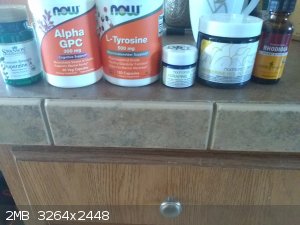
There is still more refinements to be made to the list of neurochemicals
[Edited on 12-8-2020 by symboom]
|
|
|
symboom
International Hazard
    
Posts: 1143
Registered: 11-11-2010
Location: Wrongplanet
Member Is Offline
Mood: Doing science while it is still legal since 2010
|
|
Analgesic receptors(pain relief)
Opioid - kratom/sakae naa
Opioid peptide - rhodiola rosea
Adenosine agonist- incarvillea sinesis
Opioid lettuce - adenosine receptor agonist/anticholinergic
Cannabinoid - cannabis/Zornia latifolia
Gaba agonist - skullcap
yellow horned poppy (simular to gabapentin)
PDE4 inhibitor and calcium channel blocker,
Related to energy
Kanna PDE4 inhibitor and acetylcholinesterase inhibitor
Vitex D2 Dopamine agonist
Opioid peptide releasing agent
TAAR1 agonist PEA, p-tyramine
Sigma agonist
Sigma1
Methylphenylpiracetam
Berberine
[Edited on 19-8-2020 by symboom]
|
|
|
symboom
International Hazard
    
Posts: 1143
Registered: 11-11-2010
Location: Wrongplanet
Member Is Offline
Mood: Doing science while it is still legal since 2010
|
|
Here is my herbal organization grouped in columns of
serotonin, adenosine, MAOI, opioid, cannabioid, gaba antagonist
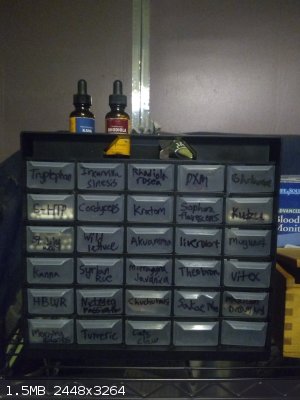
acetylcholine dopamine adrenaline
glutamate(nmda anta/AMPA) and gaba

I have been going one by one and seeing how each reacts with me a different one each day. I've also been trying to figure out organizing the columns
by increasing receptor activation as you can see with the building block chemicals to the reuptake inhibitors then to the agonists.
[Edited on 20-9-2020 by symboom]
|
|
|
symboom
International Hazard
    
Posts: 1143
Registered: 11-11-2010
Location: Wrongplanet
Member Is Offline
Mood: Doing science while it is still legal since 2010
|
|
Glutamate agonist
Willardiine occurs naturally in Mariosousa willardiana and Acacia sensu lato (mimosa, acacia, thorntree or wattle)
_______________
Opioid antagonist
Pawhuskin A, B, C
Dalea purpurea (Purple prairie clover)
The pawhuskins possess affinity for the opioid receptors and pawhuskin A, the most potent of the three, acts as an antagonist of mu, kappa,
and sigma opioid receptors.
Forskolin is an indirect KOR antagonist
------------------
Opioid
In addition to interrupting pain, they inhibit enzymes known as adenylyl cyclases (ACs) that convert cells’ energy currency, ATP, into a molecule
involved in intracellular chemical communication known as cyclic AMP (cAMP). Chronic opioid use can make cells increase the activity of ACs to
compensate, causing cAMP levels to skyrocket. When opioid users try to stop using, their cAMP levels remain high, and drugs that reduce those
levels—like buprenorphine—have unwanted side effects.
Excerpt.
https://www.sciencemag.org/news/2017/02/new-class-painkiller...
_____________
Topical pain relief
Arnica
Cloves
Electric dasiy (toothache plant)
--------------------
I thought this was interesting the antidote for deadly night shade is another poisonous plant that is extremely cholinergic effects.
Atropa belladonna has unpredictable effects.The antidote for belladonna poisoning is physostigmine the same as for atropine
physostigmine
A reversible cholinesterase inhibitor. It occurs naturally in the Calabar bean and the Manchineel tree
[Edited on 27-9-2020 by symboom]
|
|
|
symboom
International Hazard
    
Posts: 1143
Registered: 11-11-2010
Location: Wrongplanet
Member Is Offline
Mood: Doing science while it is still legal since 2010
|
|
Natural chemicals that affect enzymes
Main drug metabolism
https://en.m.wikipedia.org/wiki/Drug_metabolism
These chemicals affect the elimination of drugs from the body
Drug metabolism is divided into three phases. In phase I, enzymes such as cytochrome P450 oxidases introduce reactive or polar groups into
xenobiotics. These modified compounds are then conjugated to polar compounds in phase II reactions. These reactions are catalysed by transferase
enzymes such as glutathione S-transferases. Finally, in phase III, the conjugated xenobiotics may be further processed, before being recognised by
efflux transporters and pumped out of cells. Drug metabolism often converts lipophilic compounds into hydrophilic products that are more readily
excreted.
Maoi/cytochrome P450
Enzyme inducer or inhibitor
Enzyme activator or enzyme repressor
Oxidation
Cytochrome P450 monooxygenase system
Flavin-containing monooxygenase system
Alcohol dehydrogenase and aldehyde dehydrogenase
Monoamine oxidase
Co-oxidation by peroxidases
Reduction
NADPH-cytochrome P450 reductase
Hydrolysis
Esterases and amidase
Epoxide hydrolase
https://en.m.wikipedia.org/wiki/List_of_cytochrome_P450_modu...
InH=inhibitor
InD=inducer
CYP1A1 -->InH(cumin/turmeric/peppermint/ chamomile/dandelion/Caffeine/Echinacea/grapefruit /St.John's wort )
InD(Insulin/Modafinil/Phenytoin./Tobacco)
CYP1B1 -->InH(St John's wort) InD(. )
CYP2A6 -->InH( Entacapone/Fenofibrate/grapefruit
/Gabapentin/Modafinil/Nicotine/starfruit) InD(. )
CYP2B6 -->InH(Tumeric, Phenytoin ) InD(. )
CYP2C9 -->InH(Ginkgo biloba /St. John’s Wort/Modafinil)
InD(Phenytoin/ St. Johns Wort)
CYP2C19 -->InH(JWH-018/Modafinil InD(. )
CYP2D6 -->InH(Aspirin /Phenytoin/ Cannabidiol
/Cocaine/ Diphenhydramine /St. Johns Wort) InD(. )
CYP2E1 -->InH(Watercress /Niacin) InD(. )
CYP3A4>InH(grapefruit/Ginkgo biloba/ Milkthistle/ Niacin /Piperine/ Quercetin/Star fruit/Valerian) InD(St John's wort/
/Capsaicin/ Modafinil/ Phenytoin)
Goldenseal, with its two notable alkaloids berberine and hydrastine, alters P450-marker enzymatic activities (involving CYP2C9, CYP2D6, and CYP3A4).
Aromatase
The inhibition of aromatase can cause hypoestrogenism (low estrogen levels). The following natural products have been found to have inhibiting effects
on aromatase.
Apigenin
Arimistane
ATD
Catechin
Chalcones
Eriodictyol
Hesperetin
Isoliquiritigenin
Mangostin
Myosmine
Nicotine
Resveratrol
Reversitol
Vitamin E
Zinc
Synthetic
Clomiphene
Arom-x
Extracts of certain (white button variety: Agaricus bisporus) mushrooms have been shown to inhibit aromatase in vitro
Enzymes involved with neurochemicals
Norepinephrine/dopamine
Phenylalanine hydroxylase(phenylalanine to tyrosine)
InH(. ) InD ( .)
tyrosine hydroxylase (tyrosine to L-DOPA)
InH(. ) InD ( .)
Thyroid hormones and enzymes
[Edited on 28-9-2020 by symboom]
|
|
|
symboom
International Hazard
    
Posts: 1143
Registered: 11-11-2010
Location: Wrongplanet
Member Is Offline
Mood: Doing science while it is still legal since 2010
|
|
Norepinephrine releasing agent
Hordenine
Phenylpropanolamine
Thermogenics
increases the basal metabolic rate, thereby increasing energy expenditure
2,4-Dinitrophenol (DNP)
Phentermine
Synephrine
Phenylethylamine
ephedrine
Caffeine
Natural
goshuyu (evodia fruit)
Synephrine, Evodiamine
glucomannan
[Edited on 8-10-2020 by symboom]
|
|
|
symboom
International Hazard
    
Posts: 1143
Registered: 11-11-2010
Location: Wrongplanet
Member Is Offline
Mood: Doing science while it is still legal since 2010
|
|
www.wired.com/story/resiniferatoxin
Resiniferatoxin is 10,000 times hotter than the hottest pepper, and has features that make it promising as a painkiller of last resort.
This is interesting something that is toxic yet can cure chronic pain
Herbs that can simulate runners/rowers high
specifically phenethylamine , β-endorphin and anandamide.
Phenylethylamine, rhodiola rosea, CBD/Liverwort
Besides exercise, a medicinal herb, Rhodiola rosea is known to release beta-endorphins in the brain. This herb is used as an anti-depressant, where
Rosiridin is the medicinal component of Rhodiola sachalinensis. Rosiridin can inhibit monoamine oxidases A and B
Pain sensation
Glutamate
Substance P
Calcium
Pain killer glutamate antagonist
neurotransmitters such as glutamate and substance P cannot be released from the presynaptic terminal of the neurons. These neurotransmitters are vital
in the transmission of pain, and as β-Endorphin reduces the release of these substances, there is a strong analgesic effect.
deactivation of the calcium channel causes membrane hyperpolarization.
This is important because pain can cause a person to become inactive which in turn can cause wasting disease and muscle autotrophy.
[Edited on 20-10-2020 by symboom]
|
|
|
FragranceLover89
Hazard to Self
 
Posts: 72
Registered: 13-8-2019
Member Is Offline
|
|
I am truly concerned with your AST/ALT levels symboom if you take any of that stuff. I had a close call taking Funtumia elastica for allergies and
focus (3-Histamine antagonist). I only took 50 mg of the bark a day (much much less than recommended dose) and a random doctor appointment showed that
my AST/ALT were at 50% mortality levels. Turns of Conessine (alkaloid) is a PPI and I messed up my liver. And I had no symptoms whatsoever. I am now
diagnosed Adhd and it has really helped me. I spend less on supplements except TUDCA. lol
[Edited on 27-10-2020 by FragranceLover89]
[Edited on 27-10-2020 by FragranceLover89]
[Edited on 27-10-2020 by FragranceLover89]
[Edited on 27-10-2020 by FragranceLover89]
|
|
|
symboom
International Hazard
    
Posts: 1143
Registered: 11-11-2010
Location: Wrongplanet
Member Is Offline
Mood: Doing science while it is still legal since 2010
|
|
Histamine antagonist I don't have allergies so I don't need it. I'm sorry that happened. I don't use these herbs all the time but I wanted to
catalogue them but receptor because there is no complete list with so little information. I think the pharmacology is interesting. Thank you about
this warning about the plant some of them are great benefit but Are also poisons contain in them such as the plant that metformin is made from.
[Edited on 27-10-2020 by symboom]
|
|
|
FragranceLover89
Hazard to Self
 
Posts: 72
Registered: 13-8-2019
Member Is Offline
|
|
H3 antagonists are used primarily for narcolepsy but also might be useful for ADHD, Schizophrenia, and Alzheimer's disease.
https://en.wikipedia.org/wiki/H3_receptor_antagonist
|
|
|
karlos³
International Hazard
    
Posts: 1520
Registered: 10-1-2011
Location: yes!
Member Is Offline
Mood: oxazolidinic 8)
|
|
You might be interested in the findings of this paper: 10.3923/ijbc.2015.235.248
The really interesting bit is the following "Interestingly traces of psychoactive elements were detected. 4-methyl-2,5-dimethoxyphenethylamine,
phenethylamine, 2-methoxy-alpha-methyl-4,5-(methylenedioxy)-derivative of phenethylamines have been reported to have psychedelic effect on humans.
Those are the psychedelic 2C-D and the empathogen MMDA-2, first time found in nature!
|
|
|
symboom
International Hazard
    
Posts: 1143
Registered: 11-11-2010
Location: Wrongplanet
Member Is Offline
Mood: Doing science while it is still legal since 2010
|
|
Albizia seems to act simular to kanna
Active compound Quercitrin in
Botanical name: albizia julibrissin. Pharmaceutical name: Flos Albiziae.
https://www.ncbi.nlm.nih.gov/pmc/articles/PMC4889836/
https://planetherbs.com/research-center/specific-herbs-artic...
[Edited on 1-1-2021 by symboom]
|
|
|
| Pages:
1
2 |
|